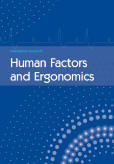Forthcoming Articles
International Journal of Human Factors and Ergonomics

Forthcoming articles have been peer-reviewed and accepted for publication but are pending final changes, are not yet published and may not appear here in their final order of publication until they are assigned to issues. Therefore, the content conforms to our standards but the presentation (e.g. typesetting and proof-reading) is not necessarily up to the Inderscience standard. Additionally, titles, authors, abstracts and keywords may change before publication. Articles will not be published until the final proofs are validated by their authors.
Forthcoming articles must be purchased for the purposes of research, teaching and private study only. These articles can be cited using the expression "in press". For example: Smith, J. (in press). Article Title. Journal Title.
 Articles marked with this shopping trolley icon are available for purchase - click on the icon to send an email request to purchase.
Articles marked with this shopping trolley icon are available for purchase - click on the icon to send an email request to purchase.
Online First articles are also listed here. Online First articles are fully citeable, complete with a DOI. They can be cited, read, and downloaded. Online First articles are published as Open Access (OA) articles to make the latest research available as early as possible.
Register for our alerting service, which notifies you by email when new issues are published online.
International Journal of Human Factors and Ergonomics (3 papers in press) Regular Issues
Abstract: Digital twin (DT) technology has significantly advanced, integrating into various industries, however, its application and implications within the human factors and ergonomics and industrial and organisational psychology fields remains underexplored. This paper explores the potential of DT technology to advance human-centric design and streamline organisational processes through a narrative review. Our analysis highlights ten critical domains where DT applications can drive meaningful improvements. The human factors and ergonomics scope includes workplace design, safety analysis, equipment optimisation, human-robot collaboration, and training simulations. In the context of industrial and organisational psychology, the focus extends to workforce planning, performance analysis, managing organisational change, promoting employee well-being, and fostering leadership development. Our findings suggest that integrating DT technology with HFE and IOP principles can lead to more efficient, safe, and productive work environments. We also discuss challenges such as data privacy concerns, technological integration hurdles, and the necessity of maintaining a human-centric focus in DT implementations. This paper contributes to the dialogue on integrating advanced technological and human-centric approaches, proposing possible pathways for future research. Keywords: digital twin; human factors and ergonomics; HFE; industrial psychology; organisational dynamics; safety analysis; performance analysis; organisational change; technology integration; skill development; training simulations. DOI: 10.1504/IJHFE.2025.10074824 Effectiveness of transfer belts and rotating discs in reducing postural load and perceived exertion in formal caregivers during patient transfers  by Carlos Manuel Escobar-Galindo, Maritza Flor Huamani-Calle, Jose Enrique Villalobos-Tupia Abstract: To evaluate the effectiveness of a transfer belt and rotating disc in reducing physical load and perceived exertion during bed-to-chair transfers among formal caregivers. A mixed-method, experimental study with 26 caregivers compared manual versus assisted transfers. Muscle activity was assessed using surface EMG, posture with the REBA method, exertion via the Borg CR-10 scale, and transfer time through video analysis. Semi-structured interviews explored user experience. No significant differences in muscle activation were found, though slight reductions were observed. Significant improvements were detected in posture, resulting in a 19% relative improvement in REBA scores, which achieved a safer postural action level when using assistive devices (p = 0.025) and a lower perceived exertion (p = 0.003). Transfer time increased slightly with devices (p = 0.0001), attributed to the learning curve. Interviews indicated improved usability, safety, and reduced strain after brief familiarisation. Although physiological changes were minimal, assistive technologies improved posture, lowered perceived effort, and enhanced transfer safety, supporting their ergonomic value in caregiver settings. Keywords: rotating disc; transfer belt; physical effort; mobilisation technologies. DOI: 10.1504/IJHFE.2025.10074374 Supporting high-speed workboat crew performance with blunt-end human factors  by Mikko Lehtimäki, Anna-Maria Teperi Abstract: Work and organisational factors (blunt-end factors) have been recognised as key features of maritime crew performance. In the case of high-speed workboats (HSWs), evidence of how blunt-end human factors (HF) are managed is lacking. This paper examined the HFs that particularly need addressing to enhance crew performance support. We obtained data from operators (n = 281) at four levels of Finnish HSW organisations (n = 5) using a questionnaire created by utilising observed phenomena affecting crew performance and the HF Tool. Results show that despite the current availability of HF knowledge, a practical shift is needed from Safety-I perspectives to the proactive and effective use of crew resources, enhanced crew competencies, unified technical solutions and procedures, and a fairer operating culture. All organisational levels in HSW organisations agreed on the areas that will need development in the future. The studys results contribute to improving the mastery of HF in the high-speed maritime sector. Keywords: high-speed workboats; HSWs; human factors; maritime safety; crew performance; HF tool; work and organisational factors; cockpit work; high-speed maritime; crew resource management. DOI: 10.1504/IJHFE.2025.10074594 |
 Open Access
Open Access